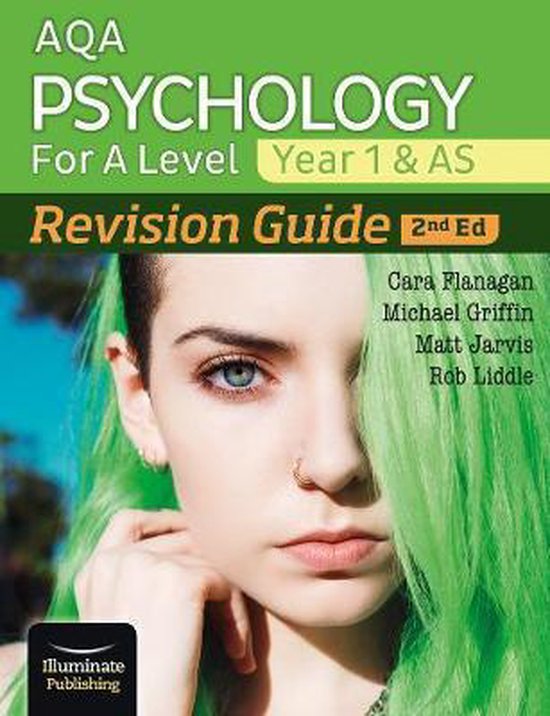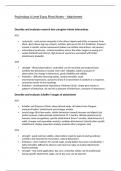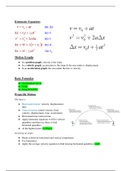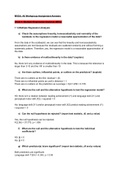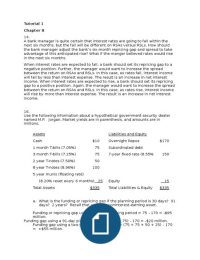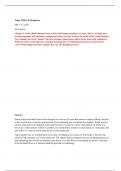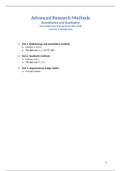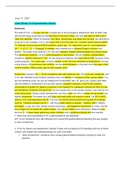Psychology A Level Essay Plans/Notes – Attachment
Describe and evaluate research into caregiver-infant interactions
AO1
reciprocity - each person responds to the others signals and elicits a response from
them, alert phases (eg eye contact), mothers pick up on this 2/3 (Feldman), frequent
around 3 months, active involvement (babies can initiate interactions, not passive)
interactional synchrony - actions/emotions mirror the other, begins as young as 2
weeks (Meltzoff and Moore), high levels of synchrony associated with better
attatchment (Isabella)
AO3
strength - filmed observations, controlled, can be recorded and analysed later
(unlikely key behaviours missed), inter rater reliability, babies unaware of
observation (no change in behaviour), good reliability and validity
limitation - difficulty observing babies, mostly immobile, small
movements/expressions, eg hard to know if a hand twitch is random or a response,
cannot be certain of any meanings
limitation - developmental importance, Feldman (2012), simply give names to
patterns of behaviour, do not tell us purpose of behaviours, unaware of importance
Describe and evaluate Schaffer’s stages of attachment
AO1
Schaffer and Emerson (1964), observational study, 60 babies from Glasgow,
measured babies’ attatchment and stranger anxiety
asocial stage (first few weeks, similar behaviour towards humans and objects but
prefer humans), indiscriminate attatchment (2-7 months, definite preference for
humans, some recognition), specific attatchment (from 7 months, attatchment to 1
adult, stranger and seperation anxiety), multiple attatchments (shortly after specific
attatchment, display seperation anxiety towards other caregivers too)
AO3
strength - good external validity, observations made by parents during ordinary
activities and reported to researchers, natural behaviours
limitation - poor evidence for asocial stage, young babies have poor coordination +
fairly immobile, difficult to observe and report on signs of anxiety/attachment,
flawed methods
strength - real world application, day care, unfamiliar adults can be problematic
during specific attachment stage, use of day care can be planned
, Discuss and evaluate what research has shown about the role of the father in
attachment
AO1
attachment to fathers - Schaffer and Emerson, 75% by 18 months ; distinctive role
for fathers - Grossman (2002), longitudinal study, quality of maternal attachment
related to adolescent attachment (not paternal), but quality of father’s play related
to quality of adolescent attachment, role with play/simulation and less emotional
development
fathers as primary attachment figures, Field (1978), primary caregiver fathers,
reciprocity + interactional synchrony, potential for emotion-focused, expressed
when primary caregiver
AO3
limitation - confusion over research questions, research into role of father as
secondary vs primary attachment figure, difficult to find specific answer, depends on
what role is discussed
limitation - conflicting evidence, longitudinal studies: secondary figures, important
role, play and stimulation ; fact studies: single parent/homosexual parent children
develop same as heterosexual parent children, question if fathers have distinctive
role remains unanswered
strength - real life application, advice to parents, mothers pressured to stay
home/fathers pressured to work, may not be best economically/lesbian/single
parents - reduce anxiety
Describe and evaluate animal studies of attachment
A01
Lorenz (1952), imprinting, hatching geese, half eggs hatched with mother, half in
incubator (first object seen was Lorenz), incubator followed Lorenz, control followed
mother, critical period (no imprinting, no attachment), sexual imprinting (peacock
attached to tortoise, only courted tortoises in adulthood)
Harlow (1958), monkeys, wire vs cloth covered, sought comfort from cloth when
frightened (mechanical teddy bear) no matter which one had milk, contact comfort
more important than food, maternal deprivation (neither were normal socially but
wire was most dysfunctional), vritical period of 90 days for attachment
AO3
strength (L) - research support, impriniting, chicks shown various moving shapes,
followed one that most closely resembled first one they saw, supports innate
machanism to imprint on moving object present in critical period
Describe and evaluate research into caregiver-infant interactions
AO1
reciprocity - each person responds to the others signals and elicits a response from
them, alert phases (eg eye contact), mothers pick up on this 2/3 (Feldman), frequent
around 3 months, active involvement (babies can initiate interactions, not passive)
interactional synchrony - actions/emotions mirror the other, begins as young as 2
weeks (Meltzoff and Moore), high levels of synchrony associated with better
attatchment (Isabella)
AO3
strength - filmed observations, controlled, can be recorded and analysed later
(unlikely key behaviours missed), inter rater reliability, babies unaware of
observation (no change in behaviour), good reliability and validity
limitation - difficulty observing babies, mostly immobile, small
movements/expressions, eg hard to know if a hand twitch is random or a response,
cannot be certain of any meanings
limitation - developmental importance, Feldman (2012), simply give names to
patterns of behaviour, do not tell us purpose of behaviours, unaware of importance
Describe and evaluate Schaffer’s stages of attachment
AO1
Schaffer and Emerson (1964), observational study, 60 babies from Glasgow,
measured babies’ attatchment and stranger anxiety
asocial stage (first few weeks, similar behaviour towards humans and objects but
prefer humans), indiscriminate attatchment (2-7 months, definite preference for
humans, some recognition), specific attatchment (from 7 months, attatchment to 1
adult, stranger and seperation anxiety), multiple attatchments (shortly after specific
attatchment, display seperation anxiety towards other caregivers too)
AO3
strength - good external validity, observations made by parents during ordinary
activities and reported to researchers, natural behaviours
limitation - poor evidence for asocial stage, young babies have poor coordination +
fairly immobile, difficult to observe and report on signs of anxiety/attachment,
flawed methods
strength - real world application, day care, unfamiliar adults can be problematic
during specific attachment stage, use of day care can be planned
, Discuss and evaluate what research has shown about the role of the father in
attachment
AO1
attachment to fathers - Schaffer and Emerson, 75% by 18 months ; distinctive role
for fathers - Grossman (2002), longitudinal study, quality of maternal attachment
related to adolescent attachment (not paternal), but quality of father’s play related
to quality of adolescent attachment, role with play/simulation and less emotional
development
fathers as primary attachment figures, Field (1978), primary caregiver fathers,
reciprocity + interactional synchrony, potential for emotion-focused, expressed
when primary caregiver
AO3
limitation - confusion over research questions, research into role of father as
secondary vs primary attachment figure, difficult to find specific answer, depends on
what role is discussed
limitation - conflicting evidence, longitudinal studies: secondary figures, important
role, play and stimulation ; fact studies: single parent/homosexual parent children
develop same as heterosexual parent children, question if fathers have distinctive
role remains unanswered
strength - real life application, advice to parents, mothers pressured to stay
home/fathers pressured to work, may not be best economically/lesbian/single
parents - reduce anxiety
Describe and evaluate animal studies of attachment
A01
Lorenz (1952), imprinting, hatching geese, half eggs hatched with mother, half in
incubator (first object seen was Lorenz), incubator followed Lorenz, control followed
mother, critical period (no imprinting, no attachment), sexual imprinting (peacock
attached to tortoise, only courted tortoises in adulthood)
Harlow (1958), monkeys, wire vs cloth covered, sought comfort from cloth when
frightened (mechanical teddy bear) no matter which one had milk, contact comfort
more important than food, maternal deprivation (neither were normal socially but
wire was most dysfunctional), vritical period of 90 days for attachment
AO3
strength (L) - research support, impriniting, chicks shown various moving shapes,
followed one that most closely resembled first one they saw, supports innate
machanism to imprint on moving object present in critical period

